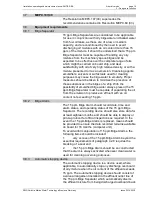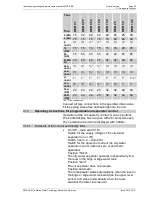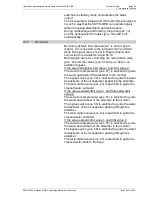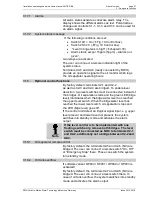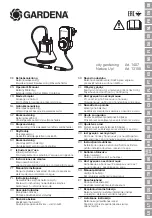
Installation, operating and maintenance manual SKIT/S-DEB
3rd print version
page 19
3 – Design and function
RWO GmbH
●
Marine Water Technology
●
Bremen
●
Germany
Issue 2014-04-10
3.7
MEPC.107(49
The Resolution MEPC.107(49) supersedes the
recommendations contained in Resolution MEPC.60 (33).
3.8
Equipment requirements
Bilge Separator
3.8.1
15 ppm Bilge Separators are considered to be applicable
for use in conjunction with oily bilgewater and ballast water
from fuel oil tanks, as these are of a low or medium
capacity, and are conditioned by the need to avoid
discharging oil mixtures with an oil content more than 15
ppm of the mixture. It should be understood that a 15 ppm
Bilge Separator must be capable of handling any oily
mixtures from the machinery space bilges and be
expected to be effective over the complete range of oils
which might be carried on board ship, and deal
satisfactorily with oil of very high relative density, or with a
mixture presented to it as an emulsion. Cleansing agents,
emulsifiers, solvents or surfactants used for cleaning
purposes may cause the bilge water to emulsify. Proper
measures should be taken to minimize the presence of
these substances in the bilges of a ship. With the
possibility of emulsified bilge water always present the 15
ppm Bilge Separator must be capable of separating the oil
from the emulsion to produce an effluent with an oil
content not exceeding 15 ppm.
Bilge Alarm
3.8.2
The 15 ppm Bilge Alarm should record date, time and
alarm status, and operating status of the 15 ppm Bilge
Separator. The recording device should also store data for
at least eighteen months and should be able to display or
print a protocol for official inspections as required. In the
event the 15 ppm Bilge Alarm is replaced, means should
be provided to ensure the data recorded remains available
on board for 18 months (computer unit).
To avoid wilful manipulation of 15 ppm Bilge Alarms, the
following items should be included:
1.
very access of the 15 ppm Bilge Alarm beyond the
essential requirements of paragraph 4.2.8 requires the
breaking of a seal and
2.
the 15 ppm Bilge Alarm should be so constructed
that the alarm is always activated whenever clean water is
used for cleaning or zeroing purposes.
Automatic stopping device
3.8.3
The automatic stopping device is a device used, where
applicable, to automatically stop any discharge overboard
of oily mixture when the oil content of the effluent exceeds
15 ppm. The automatic stopping device should consist of
a valve arrangement installed in the effluent outlet line of
the 15 ppm Bilge Separator which automatically diverts
the effluent mixture from being discharged overboard back















